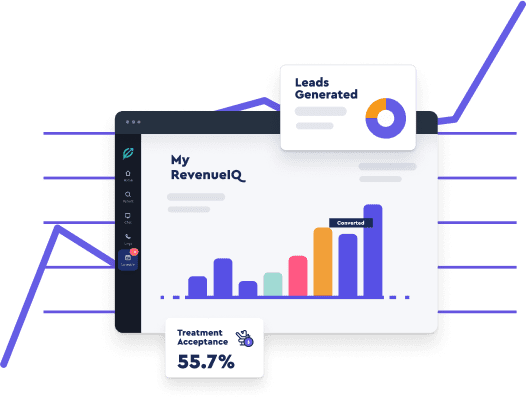Boost Productivity: Dental Office Management Essentials

Running a successful dental practice is about more than just having skilled dentists—it’s about creating an environment where everyone can focus on what they do best. Picture this: Your dental team is providing top-notch care, building lasting relationships with patients, and constantly improving services. Meanwhile, someone is handling the logistics—scheduling appointments, sending reminders, managing finances, and keeping your online presence strong. But without proper coordination, things can quickly spiral into chaos. This is where effective dental office management comes into play.
When your practice management is running smoothly, everything falls into place. Scheduling, finances, and digital presence are all seamlessly handled, freeing up your team to concentrate on providing the best care possible. It’s all about setting up systems that support growth, reduce stress, and keep your practice on track.
By taking care of these behind-the-scenes details, your practice can run like a well-oiled machine—no chaos, no stress, just great care for your patients.
What are the Key Components of Dental Practice Management?
Modern dental office management encapsulates various facets, extending from scheduling appointments and managing finances to maintaining the practice’s online presence. Let’s explore them.
1. Appointment Scheduling Systems
The right appointment scheduling system forms the cornerstone of patient satisfaction. Such a system aids smooth appointment setups and seamless schedule changes and even facilitates easy self-booking for patients. This not only enhances patient experience but also reduces the burden on office staff, offering them more time to focus on priority tasks. Below is a snapshot of the features an effective appointment scheduling system should entail:
| Essential Features | Benefits |
|---|---|
| Automated scheduling | Simplifies the process and saves time |
| Online booking | Increases convenience for patients |
| Real-time availability checking | Prevents overbooking and improves patient experience |
2. Billing and Financial Management
Solid financial management is the backbone of any successful dental practice. It goes beyond addressing patient needs, setting competitive prices, and collecting payments on time—it’s about building a strong financial foundation for long-term success.
Here’s what it includes:
- Setting the Right Prices: Charge competitively based on your market and location.
- Timely Billing: Stay on top of patient bills to maintain consistent cash flow.
- Vendor Contract Negotiations: Regularly review and renegotiate contracts to reduce costs.
- Financial Transparency: Foster trust with patients by being clear and upfront about pricing and financial matters. With Practice by Numbers (PbN’s) intuitive dashboard, you can easily track and manage your practice’s financial health through real-time reporting, automated billing, and financial forecasting tools.
Effective financial planning helps you navigate cash crunch periods and ensures your practice thrives, even during tough times. Modern financial management software can streamline processes, provide insights, and guide strategic decisions to boost revenue and drive growth.
3. Patient Records Management
Another critical component of dental practice management is the effective handling of patient records. Not only is it integral to offering personalized care, but it is also vital in remaining compliant with health regulations like HIPAA. Automated patient records management systems can significantly simplify this process with features like:
| Essential Features | Benefits |
|---|---|
| Electronic storage of patient data | Eases retrieval and update of patient records |
| Integration with appointment scheduling | Streamlines entire patient experience |
Communication Tools for Patient Engagement
Effective communication is essential for attracting new patients and keeping existing ones. It’s no longer just about phone calls—today, there are many channels to connect and engage with patients.
Here’s how modern communication can boost your practice:
- Texts & Emails: Convenient appointment scheduling and reminders.
- Social media: Showcase expertise, answer questions, and engage with the community.
- Online Information: Provide valuable patient education and health tips.
These tools help build trust, enhance patient experiences, and keep your practice top-of-mind. By meeting patients where they are, you improve satisfaction and foster long-term relationships, driving the success of your practice.
Inventory and Supply Chain Management
Inventory and supply chain management are crucial to keeping your dental practice running smoothly. Without the right supplies—whether it’s dental instruments or office materials—patient care can be delayed, and operations can grind to a halt. Efficient inventory management ensures that you never run out of essential items and helps maintain uninterrupted service.
Here’s how to keep your inventory under control:
- Regular Monitoring: Keep a close eye on your dental surgery inventory to track stock levels and anticipate needs.
- Timely Reordering: Order supplies before you run out to avoid stock-outs and last-minute rushes.
- Renegotiate with Vendors: Regularly review and renegotiate vendor contracts to secure better deals and lower costs.
- Automated Systems: Implement inventory management software to streamline tracking and ensure more accurate control.
By staying on top of your inventory, you can avoid disruptions, reduce costs, and focus more on delivering great care to your patients. Efficient supply chain management is not just a back-office task—it’s key to maintaining a smooth, successful practice.
Why is Efficient Management in Dental Practices Necessary to Optimize Growth?

So, why exactly is good dental office management vital? By administering efficient management, we can prevent potential setbacks that could hamper the success of the dental practice. Be it missing out on key financial skills, neglecting advanced communication technology, lacking business analytics insight, or deficient business leadership talent – all these voids could threaten the progression of dental practices. Efficient management will serve as the building blocks to fill these gaps efficiently, ensuring the practice thrives in the contemporary dental industry.
Impact on Patient Satisfaction and Retention
- Smooth Appointment Scheduling: Efficient management ensures appointments run on time, reducing cancellations and no-shows.
- Effective Communication: Utilizing the right channels (texts, emails, reminders) keeps patients informed and engaged, building trust and loyalty.
- Enhanced Patient Experience: A streamlined process creates a positive environment that leads to higher patient satisfaction.
- Improved Retention: A seamless experience encourages patients to return and refer your practice to others, boosting retention rates.
Effect on Operational Costs and Revenue
- Financial Control: Efficient management helps identify financial issues, allowing you to make adjustments in pricing and expenses.
- Timely Billing: Accurate billing practices help improve cash flow and prevent delays.
- Cost-effective Vendor Contracts: Regularly renegotiating contracts helps reduce supply costs.
- Technology Integration: Automated systems streamline operations, reducing overhead and improving efficiency.
- Increased Revenue: Smart financial management ensures your practice maximizes its profitability while keeping costs under control.
How to Manage A Dental Office: Tips to Supercharge Your Practice
Managing a dental practice requires a mix of organization, patient care, and efficient systems. Here are some essential tips to streamline your operations and enhance both patient experience and staff satisfaction.
1. Prioritize a Clean, Comfortable Office
Creating a space that feels welcoming can make all the difference for your patients. Use neutral colors, plenty of natural light, and comfortable seating to help your patients feel relaxed the moment they walk in. Additionally, having up-to-date reading materials also adds a nice touch.
When your office feels clean and calming, patients are more likely to return and refer others—because who wants to go to a dental office that’s uncomfortable?
2. Leverage an Easy Booking System
Simplify your booking process with a user-friendly, HIPAA-compliant system. Offering online scheduling through email, text, or a dedicated app gives patients the freedom to book, change, or cancel appointments with ease. Not only does this reduce frustration, but it also frees up your staff to focus on more important tasks, making your practice run smoother overall.
3. Clear Patient Communication
A big part of creating a positive patient experience is clear, transparent communication. From scheduling to billing to aftercare, making sure your patients understand what to expect creates trust and boosts their confidence in your practice. When they’re in the loop, they’re more likely to return and refer you to others.
4. Offer Flexible Payment Plans
Dental care can be expensive, and offering flexible payment options helps your patients get the care they need without the financial stress. Whether it’s through payment plans or discounts for upfront payments, giving your patients financial flexibility not only supports their health but also keeps your practice’s cash flow healthy.
5. Invest in High-Quality Tools & Technology
The right tools and technology can make all the difference in your practice. By investing in modern equipment, you ensure that your staff can deliver the best care efficiently while also keeping things running smoothly. Plus, top-quality tools attract skilled specialists to your team and show your patients you’re serious about providing excellent care.
6. Safeguard Patient Data
Patient data security isn’t just a legal requirement—it’s essential for maintaining trust. Make sure your practice is HIPAA-compliant by regularly reviewing and securing your systems. Protecting patient information not only keeps your practice out of legal trouble but also reassures patients that their privacy is a priority.
7. Regular Staff Training
Keep your team sharp with regular training updates. Whether it’s introducing new techniques or training on the latest equipment, making sure your staff is up-to-date ensures they’re confident in their roles and helps your practice stay ahead. Plus, it’s a great way to invest in your team’s growth and keep morale high.
8. Create a Strong Office Culture
A great office culture starts with the leadership. Encourage respect, open communication, and a focus on continuous learning. When everyone on your team feels valued and motivated, it shines through in the care you provide, creating a positive environment for both staff and patients.
9. Implement Favorable Scheduling
Balance structure with flexibility in your practice’s scheduling. By offering convenient hours and ensuring that your staff can manage their time effectively, you create a more efficient and sustainable workflow. Happy, well-rested staff means better care and a smoother-running office—everybody wins!
Role and Responsibilities of a Dental Office Manager

Efficient dental practice management wouldn’t be possible without a competent office manager steering the operations smoothly. Apart from ticking off the daily chores, a dental office manager acts as a bridge between the dentist and the administrative team, leading the strategy execution for growth. They serve as the constant point of contact around whom the entire office revolves, ensuring patient satisfaction, revenue improvements and an overall thriving practice.
Administrative and Clinical Duties
A dental office manager handles both administrative and clinical responsibilities, ensuring everything runs smoothly:
- Administrative Tasks: Manages scheduling, billing, record-keeping, and vendor coordination.
- Clinical Oversight: This may help with maintaining clinical inventory and hygiene protocols.
- Patient Communication: Handles inquiries about treatments and ensures seamless patient flow.
- Bridging the Gap: Facilitates communication between administrative and clinical teams to ensure cohesive operations.
This balance of skills ensures efficiency across all areas, enhancing both patient care and overall practice management.
Leadership and Team Management
The office manager’s role goes beyond managing tasks; they’re key to maintaining a positive, productive work environment. Here’s how they lead:
- Guiding the team: Aligning everyone with the practice’s goals and long-term vision.
- Identifying growth opportunities: Providing training and development to help the team advance.
- Conflict resolution: Keeping communication open and resolving issues efficiently.
- Recognizing contributions: Boosting morale by appreciating individual efforts.
This leadership style not only improves team performance but also enhances patient care and fosters a healthy, motivated workplace.
Challenges Faced by Dental Office Managers
The journey of dental office management, as emphasized by the American Association of Dental Office Management, is filled with challenges that require quick thinking and effective solutions. From unexpected emergencies to staff shortages, these obstacles can disrupt the smooth operation of a practice. However, with the right approach, these hurdles can be overcome. Here’s how:
Unpredictable Emergencies and Chaotic Schedules
- Challenge: Emergencies can throw off the entire day’s schedule, leading to delays and patient frustration.
- Solution: Having a flexible and dynamic scheduling system in place can help accommodate emergencies without disrupting the rest of the day. Buffer times between appointments and clear communication with patients about delays can minimize disruptions. PbN’s Patient Follow-up and Scheduling tools help optimize appointment schedules and create buffer times to handle emergencies without disrupting the day, while Daily Huddle can help staff plan for the day in just 10 minutes.
Sudden Staff Shortages
- Challenge: Unexpected staff absences, whether due to illness or personal issues, can lead to a shortage of hands on deck.
- Solution: Cross-train staff to handle multiple roles, so the team can step in when needed. Maintaining a list of reliable temporary staff or part-time workers can also provide backup in times of need. TeamChat allows for real-time communication, ensuring that all staff members are on the same page. Additionally, Kiosk can replace manual check-ins, easing workload pressure when staff are short.
Compliance Questions and Regulatory Changes
- Challenge: Navigating through ever-evolving dental regulations and compliance standards (like HIPAA) can be overwhelming.
- Solution: Regularly update policies and procedures to stay compliant. Enroll in continuing education courses or webinars to stay current on regulations. A dedicated compliance officer or consultant can also help keep things on track. PbN offers features like Insurance Verification and Digital Patient Forms, ensuring smooth compliance with billing and record-keeping regulations. You can also access real-time insights to stay updated on any new regulations.
Handling Patient Complaints and Dissatisfaction
- Challenge: Addressing patient complaints and dissatisfaction, especially when it comes to sensitive issues like treatment outcomes or office policies, can be difficult.
- Solution: Implement a clear patient feedback system, listen to complaints with empathy, and resolve issues promptly. Staff training on handling difficult situations and maintaining professionalism in all interactions can help mitigate negative experiences. PbN’s Patient Flow tools help handle emergencies without disrupting the day.
Maintaining Staff Motivation and Morale
- Challenge: Long hours and high stress can lead to burnout among the team, affecting overall performance and patient care.
- Solution: Encourage a positive work culture, recognize achievements, and offer professional development opportunities. Regular team-building activities and open communication can help maintain a motivated, happy team. PbN’s Goal Management tool enables you to set clear, attainable goals for your team, helping boost morale.
Adapting to Technological Advancements
- Challenge: The fast pace of technology changes can make it difficult to keep up, whether it’s new dental tools or management software.
- Solution: Stay proactive in adopting new technologies and offer staff training to ensure everyone is on board. Take advantage of user-friendly software that automates administrative tasks to free up time for patient care. PbN integrates multiple systems into one platform, streamlining office operations and reducing complexity. Tools like PbN AI and Voice ensure your practice keeps up with the latest tech without overwhelming your team.
Ready to Transform Your Dental Practice with Practice by Numbers?
Experience the power of a streamlined dental office with Practice by Numbers (PbN) – a comprehensive solution designed to simplify your daily operations and improve efficiency. From automated scheduling to AI-driven analytics and patient relationship management, PbN offers everything you need to optimize your practice, boost revenue, and deliver exceptional patient care while achieving excellence in service.
With PbN, you’ll:
- Simplify appointment scheduling and reduce no-shows with automated reminders.
- Enhance patient communication through text, email, and custom notifications.
- Optimize practice performance with real-time insights and financial reporting.
Ready to take control of your practice’s future?

Or Request a Demo today and see how PbN can make your practice run more efficiently.
Frequently Asked Questions
1. What are the first steps in streamlining a dental office?
The initial steps involve understanding the current systems in place and identifying areas for improvement. You must have a clear idea of your vision for the practice, including financial goals and expected patient experiences. Utilizing technology, automating processes, and investing in staff training are concrete steps toward efficient dental practice management.
What tools can help streamline the administrative tasks in my dental practice?
Cloud-based practice management software, like Practice by Numbers, automates scheduling, billing, and patient communications, reducing manual tasks. These tools also provide real-time insights and analytics to improve operational efficiency and financial performance.
2. How can I improve patient retention in my dental practice?
Improving patient retention starts with effective communication, such as timely appointment reminders and personalized follow-ups. Implementing a seamless patient experience, from easy scheduling to addressing concerns promptly, also plays a key role in building loyalty.




